Türk, T. İstenmeyen gebelik öyküsü durumuna göre kadınların aile planlaması yöntem tercihlerinin incelenmesi
Kadınların aile planlaması tercihleri
DOI:
https://doi.org/10.5281/zenodo.7523961Özet
Objective: The aim of this study is to determine differences between the family planning method choices of women with a history of unwanted pregnancy .
Material and method:This descriptive study was conducted with 300 women applied to Gynecology and Family Planning polyclinics of Lütfi Kırdar Kartal Training and Research Hospital. The working group was divided into two groups within itself according to the unwanted pregnancy history. Both groups were evaluated in terms of factors that may directly or indirectly affect unwanted pregnancies.
Results: Three hundred women participated in the study. The rate of unwanted pregnancy was 50.0% (n=150). The median of unwanted pregnancies was 4 (min:0-max: 6). Unwanted pregnancy rate is significantly higher in the 36- 45 age group (p=0.030). When the distribution of the cases
regarding the family planning method used is examined, the most preferred methods in both groups are respectively; with drawal, intauterin device and condom. When the two groups were compared, non significant difference was observed (p>0.05).
Conclusion: In conclusion, it was seen that there was nosignificant difference in terms of the methods used by the women in the two groups. For this reason, it is necessary to provide education and consultancy services to reproductive health and family planning women at every step they receive health care services.
Referanslar
Özvarış ŞB. Aile planlaması. Aktüel Tıp Dergisi 2001;6:45-51.
TC Sağlık Bakanlığı Ana Çocuk Sağlığı ve Aile Planlaması Genel Müdürlüğü, Ulusal Aile Planlaması Hizmet Rehberi 1. Ankara, 1995.
Henshaw SK. Unintended pregnancy in the United States. Fam Plan Pers 1998;30:24- 9,46.
Gichangi PB, KaranjaJG, Kigondu CS,K Knock,M Temmerman. Knowledge, attitudes and practices regarding emergency contraception among nurses and nursing students in two hospitals in Nairobi,Kenya. Contraception 1999; 59:253-256.
Bulut A. Acceptance of effective contraceptive methods after induced abortion. Study Fam Plan 1984;15(6):281-284.
Akın A, Özvarış ŞB; Ana sağlığı ve aile planlaması. In: Bertan M, Güler Ç. (Eds) HalkSağlığı (Temel Bilgiler) Güneş Kitabevi Ltd.Şt.
Ankara 1995; 135.
Sevindik FN, Acik Y, Gulbayrak C, Akgun D. Traditional methods which are known and applied in order to achieve voluntary abortion by married women living in Elazig. TAF Prev Med Bull 2007; 6: 321-4.
Yilmaz SD, Ege E, Akin B, Celik C. The reasons of induced abortion and contraceptive preference in 15-49 years women IUFN Hem Derg 2010; 18: 156- 63
Jones RK, Darroch JE, Henshaw SK. Contraceptive use among U.S. women having abortions in 2000-2001.Perspect Sex Reprod
Health 2002;34:294-303.
Westhoff C.Emergency contraception. N Eng J Med 2003;349: 1830-35.
Eggleston E. Determinants of unintended pregnancy among women in Ecuador. Int Fam Plan Pers 1999; 25: 27-33
Japarizade T, Kristesashvili J. Unintended pregnancies, their outcome and prior usage of contraception in Georgia.Iran J Pub Health
;46(2):199-206.
Nur N. Socioeconomic disparities among ever married Turkish women who had unintended pregnancies and abortions in a middle Anatolian city. Women and Health 2012;52(7):716-29.
YagoSimón T, TomásAznar C. Sociodemographic and clinical data predicting unintended pregnancy in young 13 to 24 years, Spain. Rev Esp Salud Publica 2014; 88(3):395–406.
Tezcan S, Coskun Y, Biliker MA. İstiyerek düşükler. Hacettepe Üniversitesi Nüfus Etütleri Enstitüsü Türkiye Nüfüs ve Sağlık Araştırması 2003 İleri Analiz Raporu Ankara 2005.p63-89.
Larsson M, Aneblom G, Odling V, Tyden T. Reasonsfor pregnancy termination, contraceptive habits and contraceptive failure among Swedish women requesting an early pregnancy termination. Acta Obstet Gynecol Scand 2005;81(1):64- 71.
Kost K, Singh S. Estimates of Contraceptive Failure from the 2002 National Survey of Family Growth. Contraception 2008;77(1):10-21.
Kramer MR, Hogue CR, Gaydos L. Noncontracepting Behaviour in Women at Risk for Unintended Pregnancy: What’s Religion Got to Do With It? Ann Epidemiol 2007;17(5):327-34
Galcidou E, Vayena E. Use of Modern Contraception by the Poor is Falling Behind.PloSMed 2007;4(2):381-9.

İndir
Yayınlanmış
Nasıl Atıf Yapılır
Sayı
Bölüm
Lisans
Telif Hakkı (c) 2023 Journal of One Health Research

Bu çalışma Creative Commons Attribution 4.0 International License ile lisanslanmıştır.




